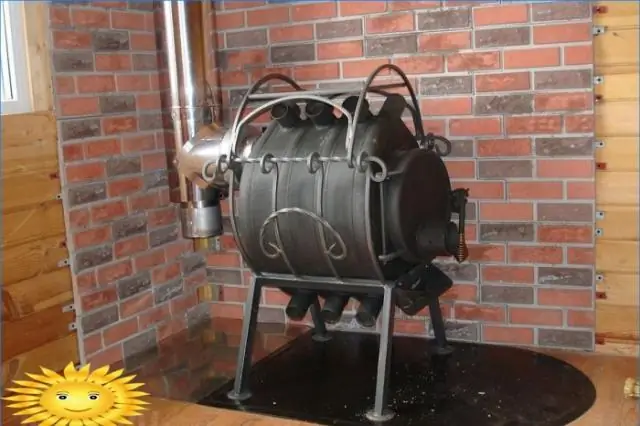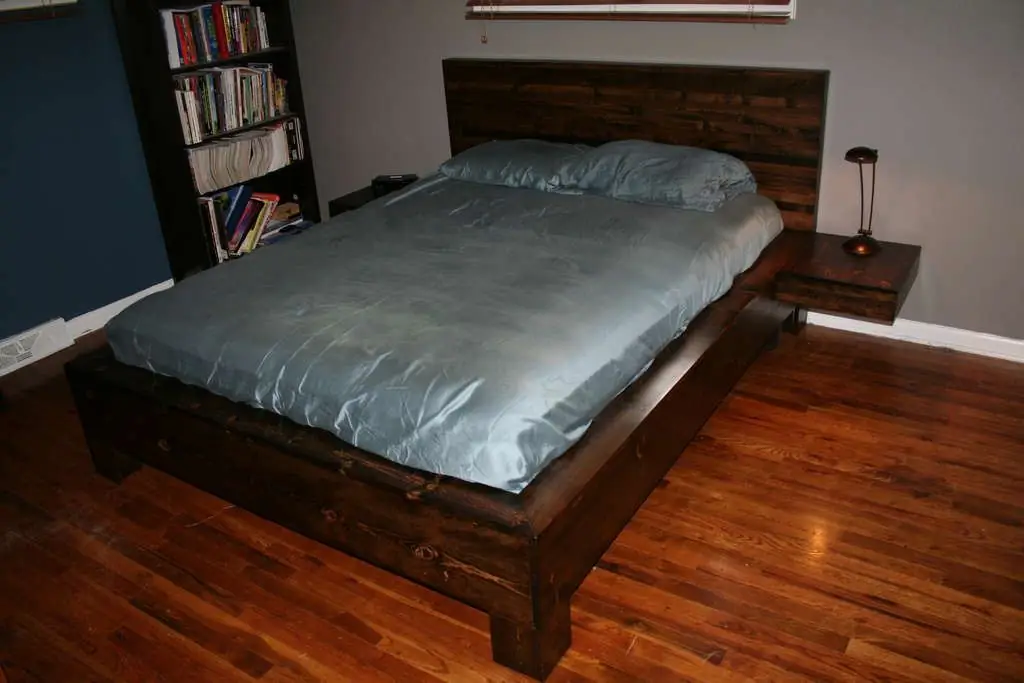
Table of contents:
- DIY bookcase
- Types of bookcases in the interior, their advantages
- We make the cabinet ourselves: the necessary materials and tools
- What to consider when drawing up a cabinet drawing
- Cooking cabinet details
- Milling the ends and back panel for the cabinet
- Let's start assembling the cabinet
- DIY bookcase assembly video
- Author Bailey Albertson [email protected].
- Public 2023-12-17 12:53.
- Last modified 2025-01-23 12:41.
DIY bookcase

Books are not only a source of knowledge that teaches life, relationships and communication culture. For people keen on literature, the book is an object of reverent worship, friend and comrade.
And despite the fact that the modern world offers a lot of opportunities to have many books in electronic form, which is much more convenient and affordable than the paper version, there should still be a library in every home. Let it be small, but filled with classical and modern literature in a traditional, familiar form.
Of course, we know that it is best to store books in cabinets specially designed for this purpose. But if you are a young family, recently bought a home and have not yet acquired the necessary furniture, then the bookcase will probably be in the last place on the shopping list. However, there is a great way out - to make a wardrobe with your own hands.
Content
- 1 Types of bookcases in the interior, their advantages
- 2 We make the cabinet ourselves: the necessary materials and tools
- 3 What to consider when drawing up a cabinet drawing
- 4 Cooking cabinet details
- 5 Milling the ends and back panel for the cabinet
- 6 Let's start assembling the cabinet
- 7 Video about assembling a bookcase with your own hands
Types of bookcases in the interior, their advantages
Now designers offer many solutions for the interior: original cabinets, unusual bookshelves. There are many options, and often among them there are simply unimaginable, but surprisingly simple to perform. Let's look at the simplest, but at the same time beautiful and interesting version of the bookcase, which is easy to make yourself.
Traditionally, bookcases come in two flavors: open and closed
- A closed cabinet is more convenient for storing paper books because it prevents sunlight, moisture and dust from entering. The disadvantage of books is that they absorb dust and moisture very strongly, deteriorate from this, which subsequently negatively affects human health. On the other hand, a bookcase, closed with solid doors, has a rather bulky appearance, and does not look very beautiful in a small room … This can be avoided if the doors are made of glass. Shaded glass protects books from the harmful effects of sunlight.
- Open bookcases look light and airy, they fit well into a room with a small footage. Usually they are narrower than closed cabinets, and are intended, in addition to storing books, for things and objects that play a role in interior decoration. If you opt for an open bookcase, then you will need to constantly maintain a certain climate in the apartment: humidity, temperature, cleanliness level. But on the other hand, such a cabinet gives easy access to books, which is very important if you like to read. Plus, open cabinets are very easy to assemble and easy to model as your imagination dictates.
Bookcases are also made in horizontal and vertical design, and in shape - rectangular, corner or shelving. Before choosing the closet that suits you, consider factors such as room space, size, and interior style.

The most popular and widespread cabinets for storing books and other things are cabinet ones. Such cabinets are available in a wide range of models, and you can easily choose how this piece of furniture will look according to your preferences: without doors or with doors of any kind - swing, sliding, accordion, glass or deaf.
The modular design of the bookcase allows various combinations of elements. Thus, you can get a cabinet of any configuration, width and height. This type of bookcase is versatile, as the variations can be easily adjusted to fit any room, large or small.
The built-in bookcase is a kind of sliding door system. All parts of such a cabinet are attached to the walls, ceiling and floor. There are a lot of design options, but the most common one is side partitions without a cover and bottom and walls of the room as boundaries.
If you have a small apartment, and there are a lot of books, then a corner cabinet will be the best solution. This design is very spacious, compact and fits well into any type of interior.
We make the cabinet ourselves: the necessary materials and tools
There are a lot of materials used for the manufacture of furniture now, and it is they that will form the value of your cabinet. Models of an exclusive character are made from expensive materials, for example, natural wood, solid wood or veneer. But for more affordable cabinets, materials such as chipboard or MDF are used, with a laminate, polymer or melamine coating. MDF is a more modern material, it is characterized by increased strength and environmental friendliness. It is produced in the form of plates by dry pressing of small chips under high pressure and temperature.
For cabinet doors, it is better to take special high-strength glass. Although it is not cheap, it can withstand a blow.

So, to make a cabinet with your own hands, you will need:
- Milling machine;
- Sander;
- Sandpaper;
- Hacksaw, drill and screwdriver;
- A hammer;
- Nails and screws with washers;
- Roulette and pencil;
- Joiner's glue;
- Varnish and stain;
- Shelf blanks made of furniture board;
- Plywood sheets for uprights, backing caps and backs;
- Natural wood beams for legs.
What to consider when drawing up a cabinet drawing

- First of all, decide on the model of the cabinet and the place in which it will stand. Divide the drawing of the cabinet into several component parts, carefully tracing every detail. Good helpers in this matter for you will be such specialized computer programs as "Basis-furniture maker" or "AutoCad". When creating drawings, take into account any little things, even the plinth on the floor of the room, which will easily eat five centimeters from the closet, and, moreover, will not allow it to be moved to the wall. In this case, the bevel of the vertical edges from the side of the plinth will help. You can also completely remove the skirting board.
- Now determine the exact dimensions of the cabinet. This means not only the width and height, but also the number of shelves, as well as the distance between them. The smallest depth of the shelf for books is 20 cm, for deeper shelves - 30 cm. The thickness of the shelf should be at least 2.5 cm with a length of 1 m, this will help to avoid sagging.
- Be sure to decide on the color of the furniture in advance. There will be no problems with this, since modern industry offers a large selection of colors and shades.
Cooking cabinet details
After all the drawings are prepared, start preparing the cabinet parts. Sawing parts is a rather difficult job, so it is better to entrust it to specialists. A chipboard sawing machine is quite expensive, and it makes no sense to buy it for the sake of making one piece of furniture. You can use a jigsaw, but the work will be, firstly, very long, and, secondly, not of sufficient quality. It is best to order a chipboard cut at the place of purchase.

Let's take a standard open-type rectangular cabinet as a basis for production. For it we will use oak veneered chipboard and oak itself. You can glue the rectangular ends of the panels with veneer, or prepare oak strips in advance, which will be glued to the ends, and rounded towards the end of the work.
- Take oak planks 30 cm wide and 3 m long, and cut them into pieces 1.6 m long. After that, you need to adjust to the size of the batten. Here you will need a board alignment template, a sawmill and a rail. The dimensions of the template are as follows: length 1500 mm, thickness - 20 mm, width - 250 mm. Place the template under the board when cutting.
- Prepare the required number of rails. They will need to be passed through the planer, while being careful: both sides should be parallel to each other and absolutely level. Also, the slats should be sanded so that the surface is perfectly smooth.
- The slats are completely ready, and now they need to be attached to the chipboard with glue. You will need a clamp at this stage. So that when the clamp is clamped, the workpiece does not squeeze through, place a piece of plywood of suitable thickness under it. When glue comes out of the seams of the parts during clamping, wipe it thoroughly with a cloth, or remove it with a chisel after drying. The slats should be joined at a 45 degree angle.
Milling the ends and back panel for the cabinet
Milling the ends is not a difficult and time-consuming job, but it still requires accuracy and care. It is necessary to choose the right cutters for the relief and clearly set the desired overhang; when feeding the workpiece into the router, it is necessary to observe the smoothness of the movements and not allow deviations to the sides.
Before starting work, check the operation of the cutter on excess trim. After the desired size is set, start processing the slats.
When the milling is complete, check that the workpiece is in contact with the work piece. If there are gaps and crotches between them, remove them with a 150 grit sandpaper. Such differences will be noticeable after you open the finished cabinet with varnish, so you need to fix them immediately.

The back of the cabinet is an inconspicuous side, so it doesn't require any special processing and finishing. But exactly how well you install it depends on the overall reliability of the entire structure. The back wall is the connector for the entire cabinet, on which all other parts are attached.
Most often, sheets or pieces of plywood are used for the back wall of furniture. Such material is very easy to process, and its installation will not take much time. Using a sawing machine or jigsaw, cut off the pieces of the desired size, and remove the chamfer from the sawn cut with sandpaper.
If you need a more reliable, sturdy back wall with high wear resistance, make it from chipboard, which is much heavier in weight. But remember that such material is much harder to process, and requires both special fasteners and certain fastening methods.
Let's start assembling the cabinet
Now you have all the necessary parts ready, and you can start directly assembling your bookcase. It must be produced on the most flat surface in order to avoid distortions.
Attach the side walls to the top, for this use a corner to prevent uneven corners at the joints. For fasteners, drill holes; use a drill with a diameter smaller than that of the connecting piece. Now pull the parts together with the fasteners. Confirmation is a very good option, it is easy to use and practical. When you buy it, you also get an Allen key, which will facilitate the clamping moment.

After you have secured the top of the cabinet, move to the bottom, while remembering to use the corner when adjusting the joints. Having connected all these parts, start assembling the shelves. Take your time to fix the back wall, without it, the installation of the shelves will be much easier and more convenient. Since the shelves of the bookcase are constantly exposed to stress, it is not worth making them removable. It is easier to fix them with the same confirmation, and it is best to make 3-4 fasteners for each of the side walls. Thus, not only the shelves, but the entire cabinet will receive additional stability and reliability.
So, we have come to the final stage - the installation of the back wall. In the event that you opted for chipboard, a construction stapler, screws or nails will serve as fasteners.
DIY bookcase assembly video
Well, now you have an original bookcase in your apartment that you assembled yourself. As you can see, this work is not only simple, but also does not require large financial costs. Now in your interior there is an exclusive piece of furniture that cost you much cheaper than store counterparts. And if you have any questions, you can ask them in the comments, we will be happy to answer them.
Recommended:
Making Garden Paths With Your Own Hands - Tips + Video

Practical advice on the construction of paths in the garden. Materials used, recommendations
Apple Wine Recipe: How To Make This Drink With Your Own Hands (with Video)

A step-by-step recipe for making apple wine at home. Necessary products, tools. Features of making wine, recommendations
How To Make A Garden Fountain With Your Own Hands In The Country: Photo, Video, Step By Step Instructions

A step-by-step description of the process of building and installing a fountain from improvised means in the country with your own hands Required materials and tools
Making A Buleryan (breneran) Stove With Your Own Hands: Advantages And Disadvantages Of The Design, A Device With Drawings, Instructions With A Video, Etc

Design and principle of operation of the "Buleryan" furnace (breran). DIY recommendations with instructions and drawings. Maintenance and operation
Making An Exclusive Bed With Your Own Hands With Video

Step-by-step instructions for making an exclusive bed model: the necessary materials and tools for installing the bed
